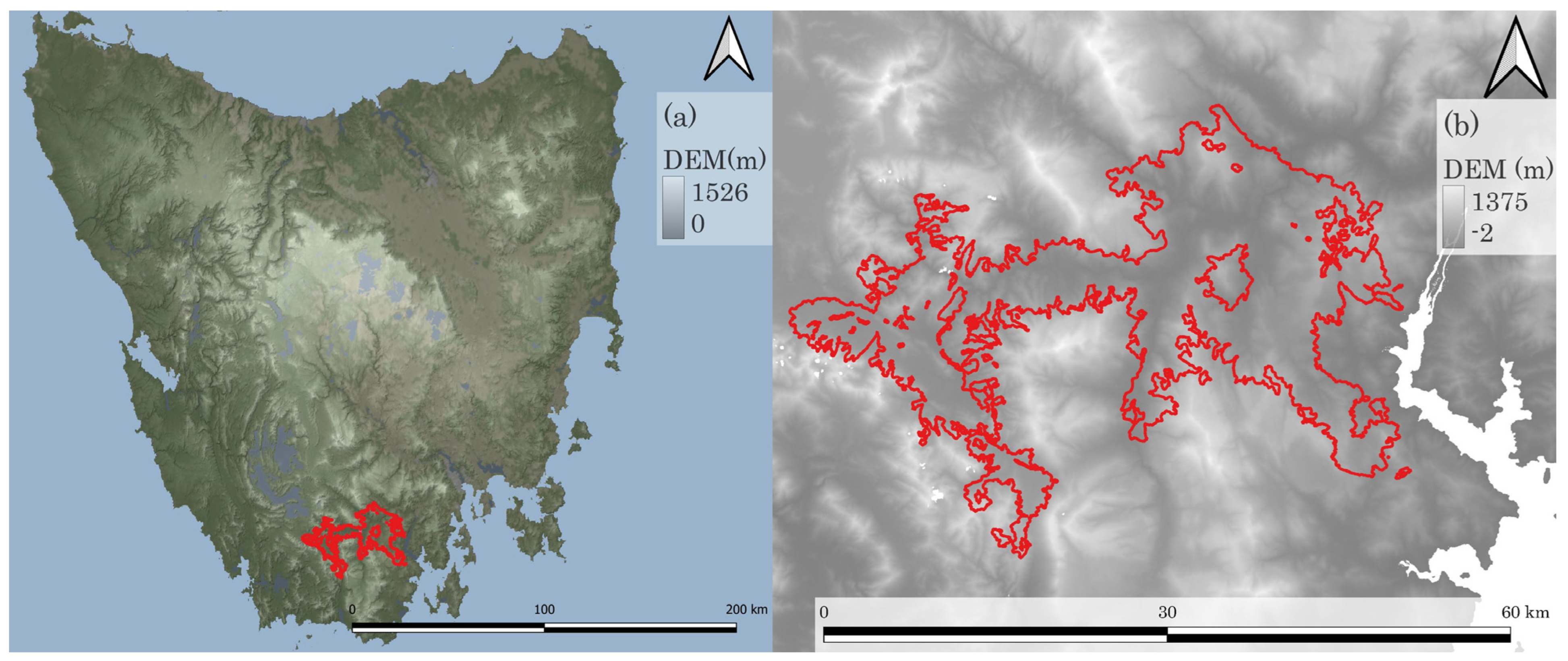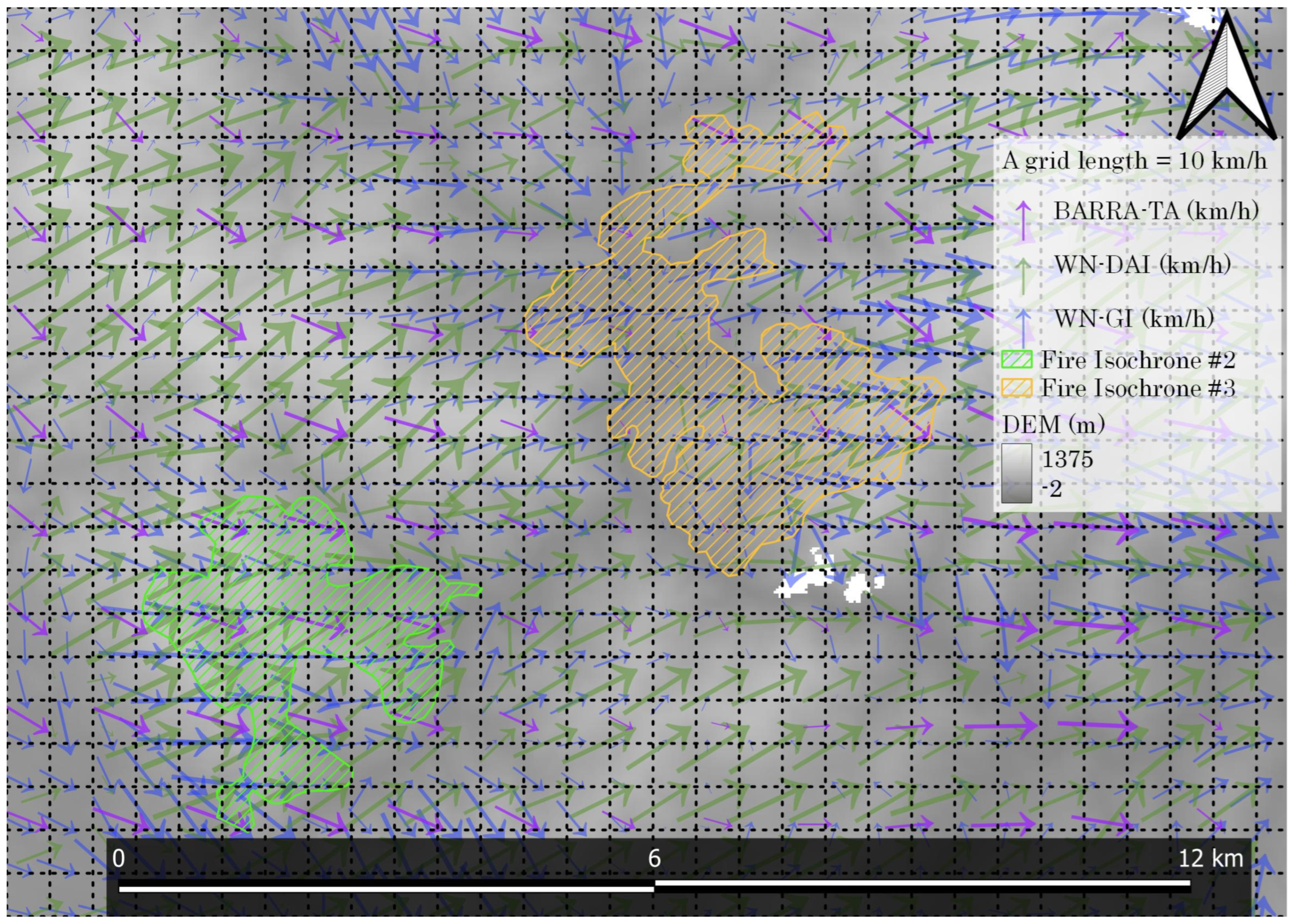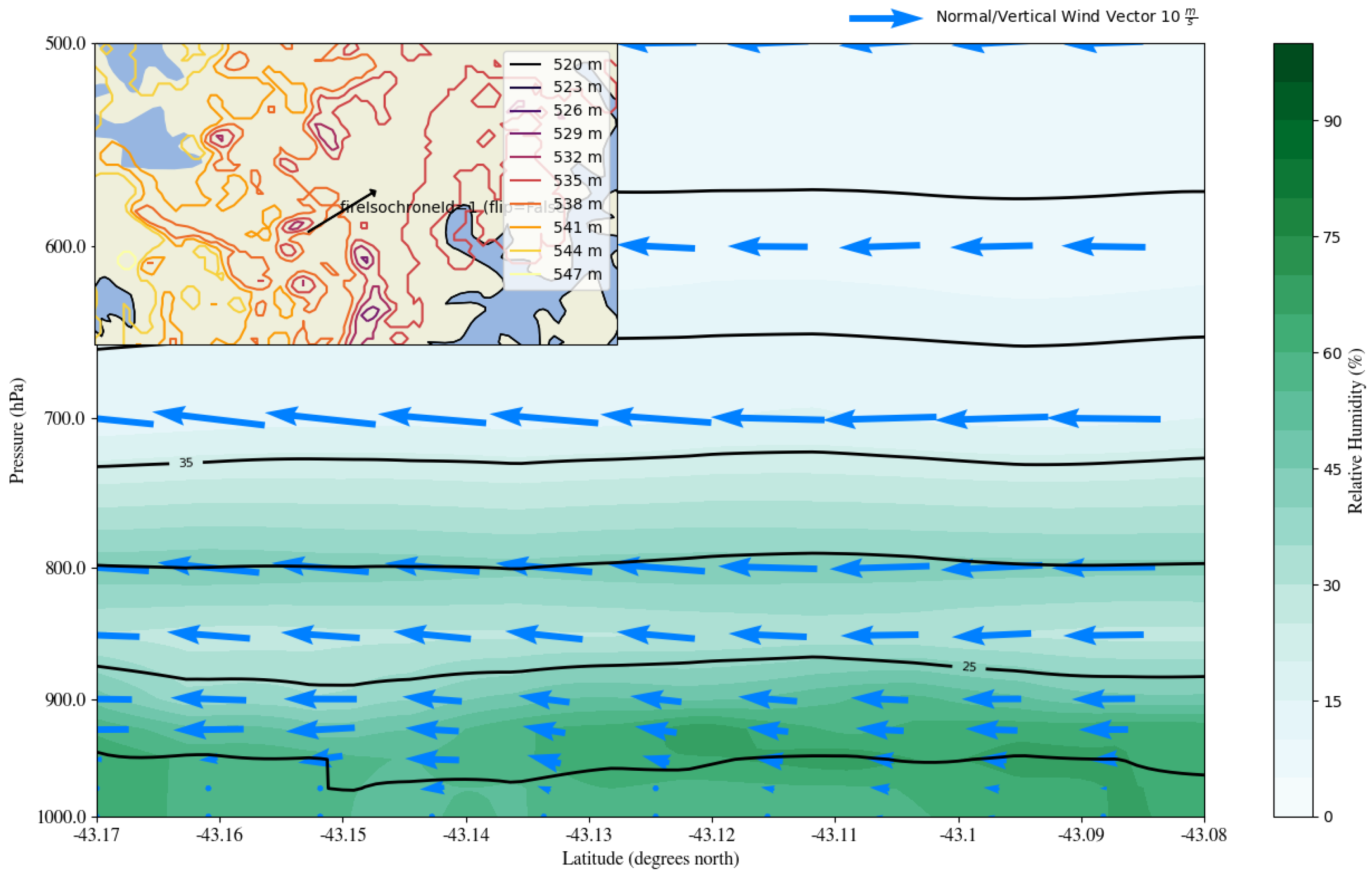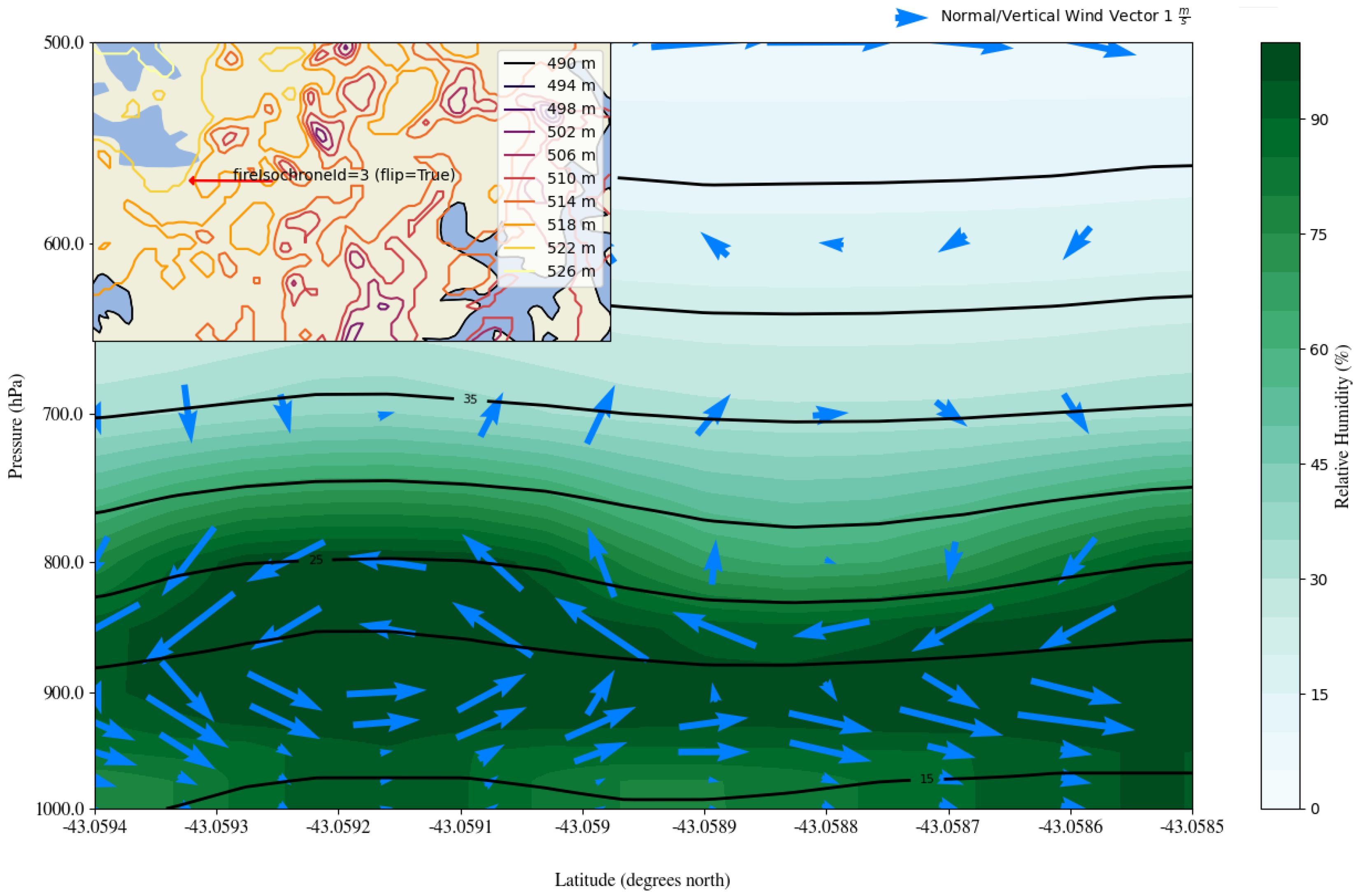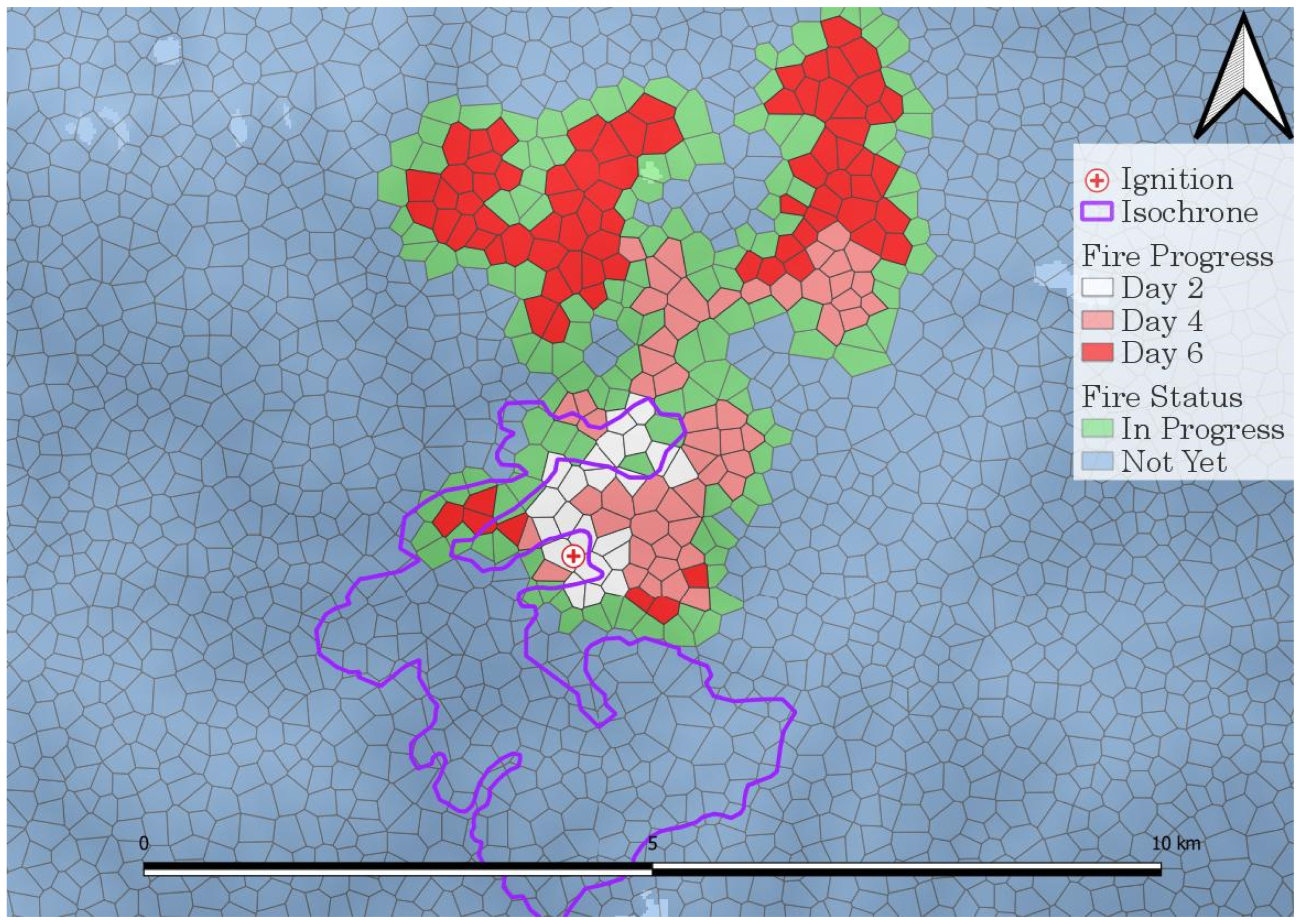1. Introduction
Recent fire events in Australia have highlighted the urgent necessity to develop better predictive models of fire behavior. Fires are important natural processes in many ecosystems. For instance, fires promote growth by introducing nutrients into the soil derived from the ashes produced, they can act as a successional disturbance, by removing competition and opening the canopies in forests, which encourages the establishment of seedlings, and they can trigger seed germination. On the other hand, fires cause the destruction of human lives and property. For example, the Black Saturday Fires in 2009 killed 173 people and destroyed more than 2000 houses in Victoria, Australia, the Ash Wednesday Fires in 1983 resulted in 75 fatalities and the loss of 1900 houses in South Australia and Victoria, and the Black Tuesday Fires in 1967 cost 62 lives and destroyed 1300 houses in Tasmania [
1,
2,
3]. In recent fires, the death toll from wildfires rose to 33 in the Black Summer fires between 2019 and 2020 in eastern Australia [
4,
5].
These fires propagated in not only flat or mild terrain but also mountainous areas [
6,
7,
8]; yet, fires behave differently on slopes compared to flat or less topographically diverse regions. For instance, fires generally propagate more rapidly uphill than downhill [
9] and it is often difficult to predict the fire spread and behavior in rugged terrain because the weather interacts with the more complex topography. For instance, such topography is favorable for thermally induced winds which often lead to unexpected fire behaviors [
10]. In general, the solar radiation is higher, temperature is lower, humidity is lower, and the wind is stronger in mountainous areas than in lowlands [
11,
12]. These weather conditions also influence the fire propagation. Such interactions in rugged terrain often expose fire crews to greater risk when fighting fires in these areas than in flat or less rugged areas [
13]. Additionally, these interactions pose a risk to tourists and people engaging in sports activities such as hiking and rock climbing in the mountains [
14], as a fire spread direction may run contrary to expectations and the conditions may change rapidly. Further, the by-products of fires, such as smoke pollution, can have negative impacts on broad areas, including nearby densely populated regions [
15]. For instance, smoke from wildfires and prescribed fires contains harmful particles for the respiratory organs and these pollutants are often referred to as atmospheric particulate matter (PM) and can be transported for long distances [
4]; therefore, wildfires in mountainous areas can affect not only nearby locations but also distant areas.
Fire behavior is the result of interactions between the topography, fuel, and weather, such as the temperature, relative humidity, wind magnitude and direction [
16,
17]. In particular, wind plays a significant role in fire propagation in rugged terrain and exhibits various dynamic forms that strongly interact with the topography [
11,
16,
18,
19,
20,
21]. There are several dynamic wind forms of relevance to fire spread, including diurnal wind, pressure driven channeling, the downward transport of momentum and forced channeling. Diurnal winds occur when the micro-scale (<2 km) or meso-scale (2–200 km) atmospheric winds dominate while other dynamic winds are observed when the larger scale atmosphere is more influential [
11]. On the other hand, the micro-scale atmosphere can also influence the larger scale atmosphere. For instance, nocturnal airflows subsiding from higher mountains frequently spread out and trigger mesoscale convective systems [
22]. By contrast, forced channeling and pressure driven channeling result from synoptic scale atmospheric phenomena. Specifically, forced channeling is the result of a deflection of the geostrophic wind aloft by the surface topography. The direction of the forced channeling can suddenly shift by 180 degrees in response to even small changes in the geostrophic wind aloft. Meanwhile, pressure driven channeling results from the presence of a pressure gap within a valley, with the valley wind blowing from high to low pressure areas, and therefore is often known as a gap wind. Downward transfer of momentum is the dynamic wind caused by vertical mixing or gravity waves and is often observed with forced channeling. These upper winds may cause a fanning effect on the fire propagation in the valley, altering the rates and direction of spread in addition to the effect of the surface wind [
10,
19,
23,
24,
25].
We present a case-study into fire behaviors in rugged terrain in Australia that will inform the development of a new generation of fire spread simulators. We aim to understand the impact of vertical atmospheric interactions on fire spread in rugged terrain. Two methodologies were employed: an examination of atmospheric cross-section plots, and a simulation of fire spread using the Prototype 2 simulator. A cross-section is a diagram that projects the elevated air in a vertical profile based on interpolated weather data. We used cross-section diagrams constructed for segments of the fire to quantitatively assess the upper-air interactions. On the other hand, the Prototype 2 is a new fire simulator for fire propagation that has been implemented by following the draft specification of the Australian Fire Danger Rating System (AFDRS) [
26].
The datasets required for these methodologies were fire isochrones, vegetation mapping, topographical and geological data, and the Bureau of Meteorology high-resolution Regional Reanalysis for Australia for Tasmania region (BARRA-TA). For the Prototype 2 simulations, three analysis groups were prepared with different types of wind to identify an impact of upper air interaction. The first was an experiment group which reflected the upper air interaction better than the other groups because the wind data are directly retrieved from BARRA-TA, which incorporates full, three-dimensional vertical wind modelling. The second and third were the control groups which contained the wind downscaled by WindNinja, a numerical diagnostic tool which improves the horizontal resolution of wind fields, but which does not directly ingest upper air. The difference between the two control groups was the parameterization of source wind data: the domain average initialization (WN-DAI) and gridded initialization (WN-GI). A wind was downscaled from a single location per time episode with the WN-DAI while a grid-based wind, which was reprojected from BARRA-TA, was generated with the other option, the WN-GI.
Our research aimed to determine whether upper air winds had greater impacts on a fire simulation in rugged terrain than in other, less topographically complex areas of the fire. The hypotheses to address the research objective were (1) conducive winds would be more frequently observed in rugged terrain than milder topography in the study area, and (2) the quality of the fire simulation would be lower in rugged terrain than in mild topography due to an inadequate consideration of the disruption of upper air. Note that there should be ideally only one variable changing in the comparison between the three groups, which is the influence of the upper air interaction among three groups; however, the spatial resolution also varies in BARRA-TA (1.5 km), WN-DAI (637 m) and WN-GI (447 m) due to their different preprocesses. Although the resolutions of the downscaled wind were finer and topographically more sensitive than that of the BARRA-TA dataset, these wind fields are less affected by upper air interaction. Indeed, there is an interface available for the ground surface level only in WindNinja 3.7.3; therefore, the experiment group based on BARRA-TA was expected to produce better results on the fire simulation when an upper air interaction took place. In other words, the simulations with WN-DAI, which was one of control groups, were expected to produce the lowest scores when the upper air interaction was active, since assimilated weather is ingested from only a single location per time episode.
4. Discussion
The fire models embedded in Prototype 2 ingest topography, fuel, and ground surface weather; however, it is also necessary to consider the vertical atmospheric interaction for fire simulation when synoptic or mesoscale weather is dominant or in rugged terrain. Three types of winds were ingested to simulate fire propagation. One was the coarse wind from BARRA-TA datasets, with a resolution of approximately 1.5 km. This dataset was reanalysis data, calculated using a sophisticated numerical weather prediction model and assimilated with historical weather parameters; therefore, various dynamic winds, such as diurnal wind, forced channeling and pressure driven winds, were represented within this wind field input. Although the other two wind fields downscaled by WindNinja were of a finer horizontal resolution than the BARRA-TA, and took into account the diurnal wind and atmospheric stability at the ground surface level, these fell short of the ability to model full, three-dimensional wind fields. Despite the higher resolution of the WindNinja output, the simulations with these downscaled wind fields showed a lower quality than the BARRA-TA in rugged terrain (
Table 10).
First and foremost, the number of conducive structures was higher in more rugged terrain. The most conducive structures were observed as 40.15% in fire isochrone #3, in which there was the greatest elevation gap within the area, 619 m, among the three isochrones. This tendency agrees with the first hypothesis, that turbulent flows over the topography are more frequently observed in more rugged terrain.
Secondly, the quality of the fire simulation appeared mostly negatively related to the ruggedness and the number of conducive structures. For instance, the percentages of the fractions skill scores (FSS) were the best and the number of conducive structures was the least in isochrone #1, which was situated in the least rugged terrain, and this was consistent across all wind field models. This tendency partially confirms the second hypothesis. On the other hand, the FSS in #3 with the grid-based downscaled wind input (WN-GI), was 20%, which was poorer than the model parameterized with a single wind location input (WN-DIA), 40%, even though the former considered more assimilated data as a grid field than the latter; however, this gap is considered as marginal from the perspective of the median values of these FSS. In fact, these median values are very close each other, 0.49 and 0.47, with the WN-DAI and WN-GI, respectively, in fire isochrone #3, and both are less than the threshold, “useful”; therefore, the difference of the FSS between the WN-DAI and WN-GI is not reliable to confirm the second hypothesis thoroughly. The interpolation in the downscaled data is a result of fluid computation along the terrain, incorporating the diurnal wind and atmospheric stability at the ground surface level; however, upper weather can disrupt the surface flow, and this is not fully accounted for in the downscaled model. Diurnal wind is often subdued when synoptic or mesoscale wind is dominant. If the diurnal wind were dominant, the simulated fire would have agreed with the observed fire more. On the other hand, the dominance of larger scale weather is not always necessary in rugged terrain to intervene in the surface flow because upper air can interfere with it when there is a significant elevation gap from the adjacent location. For instance, if there is a weather station on a crest, which is surrounded by the upper air far above the neighbor’s surface locations, the surface wind is affected by these surrounding winds aloft; however, the interpolated wind ingested by Prototype 2 did not reflect the upper air but was influenced by the surface factors nearby only.
Overall, it is necessary to consider the vertical atmospheric interaction in rugged terrain in the developing AFDRS. Although several efforts have been made in Prototype 2, an analysis of 10 m wind alone is not sufficient because the upper air appeared to affect the fire propagation. As a solution, it is necessary to acquire a finer-scale wind field than the BARRA-TA by incorporating upper air interactions. There are different advantages and drawbacks in each type of wind in the study case. Although the downscaled winds are of a finer resolution than the BARRA-TA, they do not fully incorporate upper air interactions. On the other hand, the BARRA-TA contains upper air interaction but is only available at a much coarser resolution. To improve the preprocessing of the wind field, it is necessary to investigate the upper air interaction in advance. In fact, there are various types of dynamic wind, such as forced channeling wind in mountainous regions; therefore, it is necessary to identify the types of dynamic wind in such an area. If the dynamic winds are incorporated at the preprocessing stage, it would be of some help to improve the fire prediction model in rugged terrain, and the improved model performance would be beneficial for fire crews in these areas to avoid collateral damages.
5. Limitations
The fire spread modelling undertaken in this study does have some limitations in the BARRA-TA, WindNinja, calculation of slope for the rate of fire spreading (ROS), fire coalescence, and the interaction of fire and atmosphere.
Firstly, the BARRA-TA has limitations for resolution and the accuracy of humidity modelling. In terms of the resolution of both the weather data and topography in the BARRA-TA, it was 1.5 km and coarser than the wind data downscaled by WindNinja and the digital elevation model (DEM), which was ingested to simulate fires and whose spatial resolution was approximately 27 m; however, it appears to be resolved enough to adequately profile the upper air. Indeed, the fire simulation parameterized with the BARRA-TA surface wind performed more accurately in rugged terrain than the finer downscaled winds; therefore, it partially achieved the purpose of this study despite a coarse spatial resolution. The BARRA-TA also includes 21 atmospheric pressure levels in the vertical atmospheric data, all of which contain parameters such as air temperature, relative humidity, and wind magnitude and direction [
54]; however, there are known limitations in the ability of meteorological reanalysis models to capture the vertical distribution of humidity, due to the difficulty in deriving humidity from satellite models [
55,
56].
The second series of constraints are for WindNinja, a diagnostic tool to interpolate and downscale the wind data. For example, the Coriolis force is disregarded in WindNinja because the scale of the affected area is small [
21,
44].
The third limitation is the topographical coefficient on the rate of spread (ROS). In terms of the topographical effect on the ROS, Prototype 2 provides two calculations about the downslope distance: the plan/projected and linear/ground katabatic slope. The plan/projected slope distance is, in general, suitable for large areas while the linear/ground katabatic slope is suitable for small scale simulations [
9]. Because the threshold or criterion for which the slope distance is to be used is not articulated, the results with both distances are addressed in this study. Despite employing both methods, they did not show much difference of quality in this study [
9]. The details of the results with these different slope distance methods are addressed in
Section S3, File S1. Note that there is only one way of calculating the anabatic slope distance employed.
The fourth limitation is the treatment of fire coalescence, which is not considered in this study due to the high computational requirement, and which prevented the incorporation of the acceleration of fire propagation coalescence [
45]. Fire isochrone #1 contained two ignition points whose distance was approximately 160 m, but as the duration gap between these was approximately two days, coalescence effects appear unlikely.
The last limitation is the fire–atmospheric interaction. A fire interacts with the atmosphere by driving convection, the fire coalescence mentioned above, and a coupled fire-atmosphere (CFA) model is expected to predict the fire behavior; however, a CFA was not employed due to the high computational intensity [
57].
